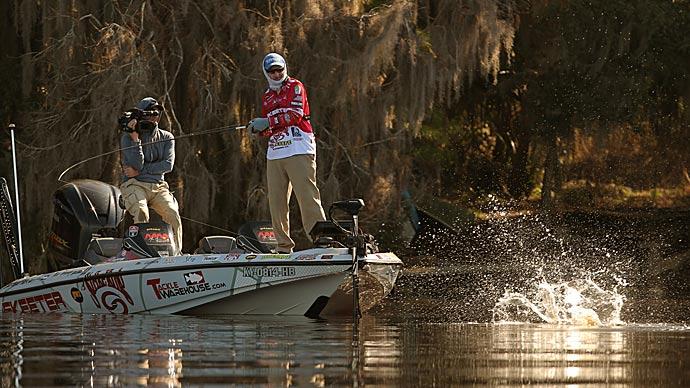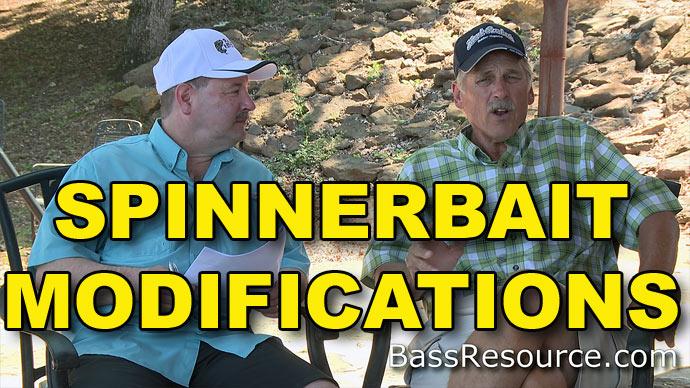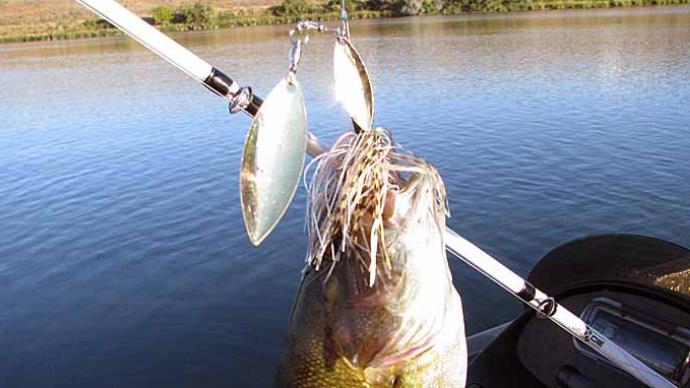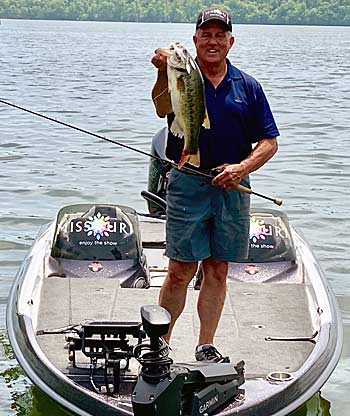
Simplicity and versatility have made the spinnerbait one of the greatest bass lures of all time.
Although he has relied on a jig for most of his tournament successes, Scott Pauley still keeps spinnerbaits well-stocked in his tackle system. The Missouri Division of Tourism's Outdoors Ambassador believes a spinnerbait is effective because it mainly imitates a shad, a primary food source for bass in the Midwest reservoirs he fishes.
“It also covers many water depths, and you can cover a lot of water fast with it," Pauley says. "The best spinnerbait fishermen tend to quickly fish it up (in the water column)." He suggests that when the lure is riding high in the water column, bass are looking up at it and see the blades sparkle, which tricks the fish into thinking it is a shad and triggers a reaction strike.
The versatility of a spinnerbait with its various blade sizes and shapes and body weights makes it a lure for all seasons. Various blade configurations and body weights allow Pauley to either slow roll a spinnerbait for lethargic winter and prespawn bass or wake a blade bait on the surface for aggressive bass throughout the warmer months.
Pauley believes the optimal time to start throwing a spinnerbait in the spring is when the water temperature climbs into the upper 50- or lower 60-degree range. He notices bass start chasing a moving spinnerbait more and ignore the paused, suspending jerkbait they have been eating all winter.
“The key for a spinnerbait is finding the right conditions," Pauley says. “Some guys like to use them on cloudy, rainy days; Gayle Julian (owner of Jewel Bait Company) is one of the best spinnerbait fishermen I have ever fished with, and he likes to use it on a bright sunny day with wind." He notices Julian retrieves his blade bait fast and erratic, slightly under the surface, to draw reaction strikes.
Pauley determines the blade sizes of his spinnerbait by the time of year and the size of the forage. Pauley prefers spinnerbaits with small blades to match the hatch during the post-spawn when bass eat their own fry. However, the Missouri angler switches to magnum-size blades when bass are gorging on large shad in the fall.

Water clarity helps Pauley determine which blade styles to select for his spinnerbaits. Bass have to rely more on their lateral lines than their eyes to find baits in murky water, so Pauley opts for thumping Colorado blades that produce lots of vibration for bass to track down. Bass can rely more on their vision in clear water, so Pauley selects willowleaf blades that produce plenty of flash for bass to see. A spinnerbait with Indiana blades is a good option for stained water because it produces vibration and flash.
Spinnerbaits produce well around rocks, docks, and wood. "I like to fish a spinnerbait around wood, bringing it over the wood, then killing it and letting it fall," Pauley says. In addition, the tournament veteran favors running a spinnerbait along the sides and corners of floating docks to draw reaction strikes from bass suspended under the docks.
Pauley’s gear for his spinnerbait tactics consist of a 7-foot medium-heavy action casting rod and a 6.3:1 or 6.4:1 gear ratio baitcast reel filled with 20-pound fluorocarbon line. He scales down slightly to lighter line when fishing a blade bait in clear water. “I want to go with as heavy of a line as I can get away with so I don’t get broke off,” he says.
War Eagle spinnerbaits are Pauley’s favorite skirted blade baits. He usually combines the blade bait with a plastic trailer such as the Zoom Split Tail Trailer. He also adds some insurance to his spinnerbait hook. “I almost always use a trailer hook because there will be short strikes," he says. However, Pauley discards the trailer hook if he is fishing around gnarly cover to avoid constantly hanging up.
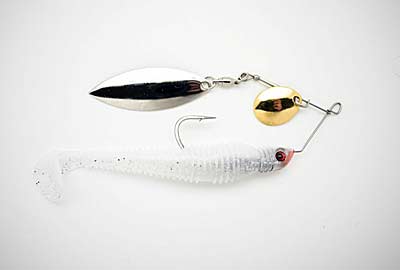
Pauley has recently adopted the Jewel Bait Gem Series to simplify his spinnerbait fishing. He suggests the Gem Series is a spinnerbait/swimbait system that makes it easier for novices to choose lures. The series starts with a Gem Shad, which Pauley describes as a swimbait jighead designed to match a 4.8-inch Keitech Swing Impact FAT Swimbait. The lure can be fished shallow or deep, around cover or open water, and on calm days when bass tend to ignore a spinnerbait.
The next lure in the series Pauley uses is the Gem Spin, an underspin jighead with a small willowleaf blade. The spinner, also designed for the same 4.8-inch Keitech swimbait, produces strikes for Pauley when he drags it along pea gravel bottoms.
The Gem Blade is Pauley's choice for most of his spinnerbait tactics because it allows him to fish it in calm or windy conditions, whereas the Gem Spin and Gem Shad are more subtle finesse-style baits for calmer weather. In addition, he considers the Gem Blade a regular double-bladed spinnerbait with the skirt replaced by the 4.8-inch Keitech swimbait.
If conditions call for finesse tactics or the waters contain smaller baitfish, Pauley scales down to the Gem Series 2.0 lures. In this series, the Gem Shad, Gem Spin, and Gem Blade are designed to fit 3.3- and 3.8-inch Keitech Swing Impact FAT Swimbaits as trailers. Pauley suggests these smaller profile baits are ideal for throwing on spinning tackle.
BassResource may receive a portion of revenues if you make a purchase using a link above.


